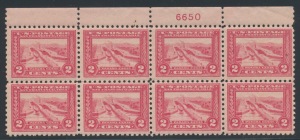Probably no area of US philately has changed more over the last century than the collecting of US plate blocks. Ours was the first nation to collect plate blocks, and really is still the only country that does (Canadian collectors, UN collectors and Israel collectors have small plate block contingents, but these are derivative from US collecting, mainly appealing to Americans whose interest has migrated away from US philately and don’t represent an indigenous specialty of their own). We are so far away from it now that few are aware of why plate number collecting began in the first place. The great American experiment of outsourcing government services to private companies was tried before, and the postal story was one of the first. Before 1894, our Post Office contracted with private printers for printing and design of US postage stamps. Several companies were used through the nineteenth century. By the early 1890s, the Post Office was no longer convinced that the deal it was getting from the American Bank Note company was such a good one. The ABNC had been merged together from several smaller printing companies and for a long time had a near monopoly on the security printing market. The Post Office turned to the Bureau of Engraving and Printing in 1894, and this began the 125 year practice of our government producing most of its own postage stamps.
The Bureau did all our government’s security printing including currency and bonds. They knew that they had the contract for a long time and wished to keep very careful records. Each stamp printing plate, as it was prepared, was numbered, and this number printed in the margin of the sheet. There was no intention to create collectible varieties for collectors, and for many years collectors argued over the best way to collect plate numbers. The very first collectors simply collected the plate number tab itself, and you still see a few collections today that have just printed plate numbers on tabs mounted consecutively (this isn’t as weird as it sounds


